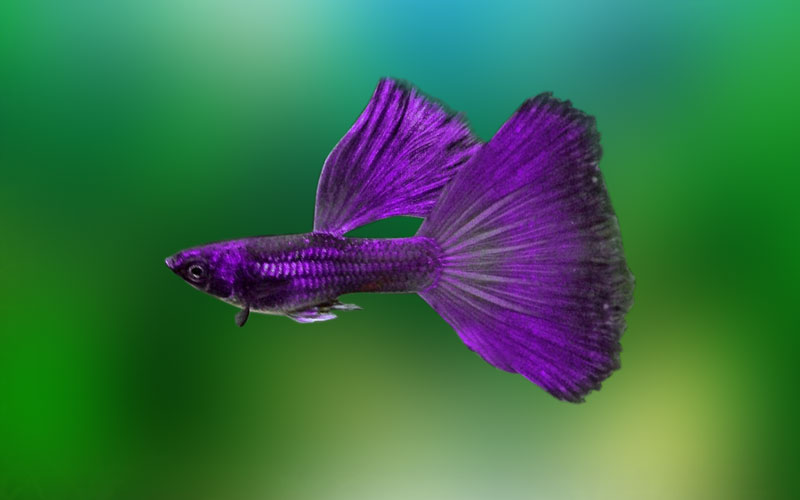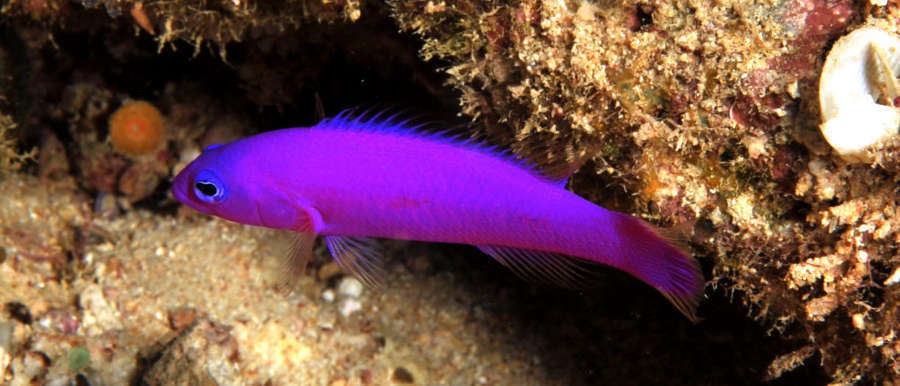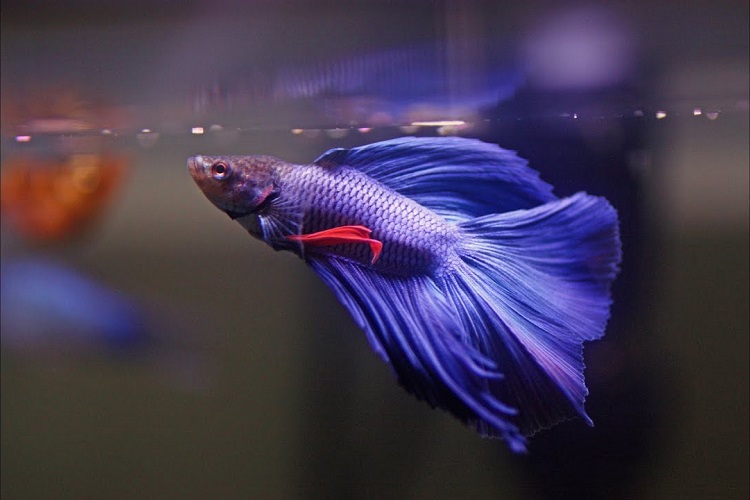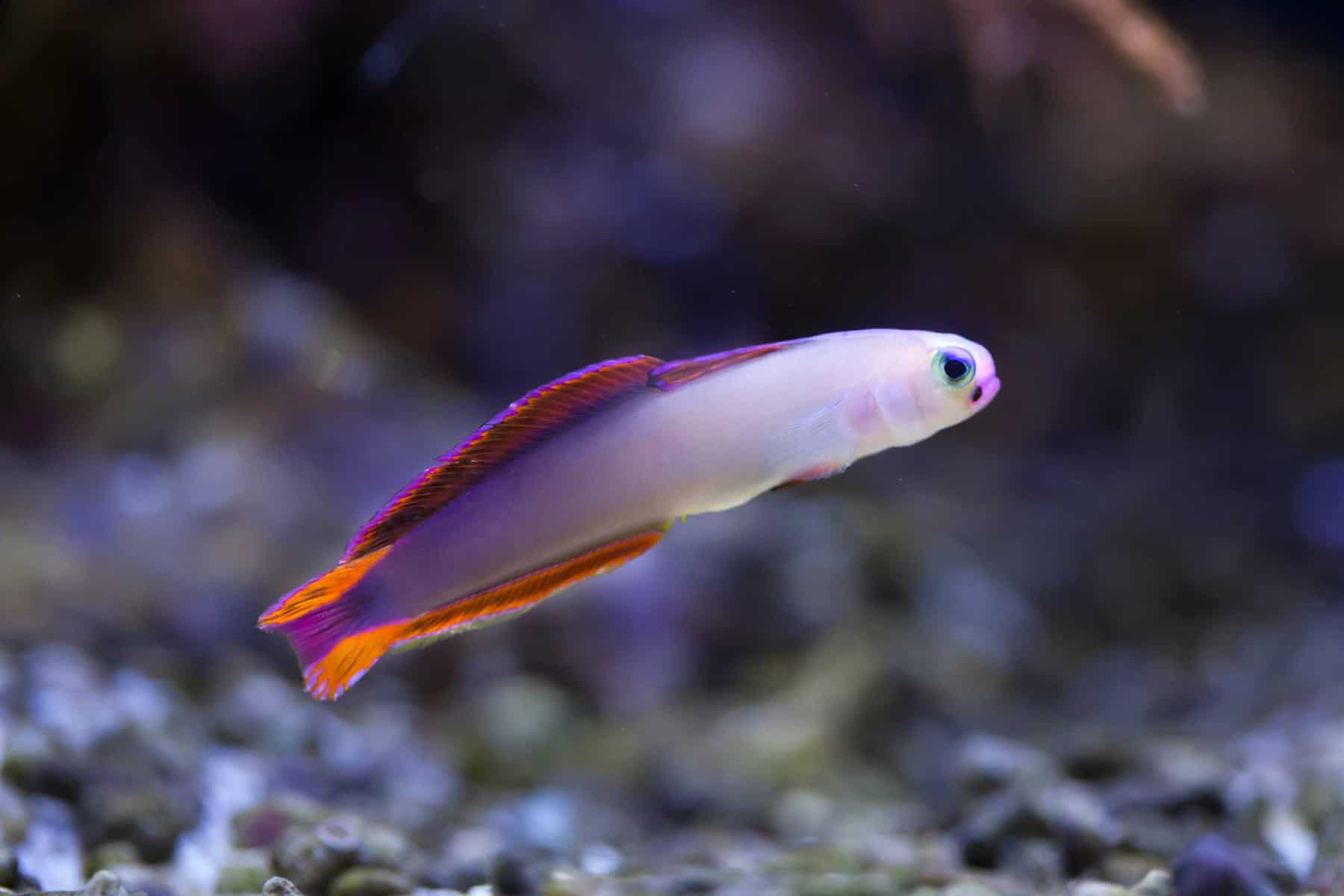If you’re looking to add some color to your aquarium, purple fish can be a great choice. There are several types of purple fish that can be kept in an aquarium, ranging from freshwater to saltwater species.
In this article, we will explore some of the most popular types of purple fish to own, including their unique characteristics and care requirements. Whether you’re a beginner or an experienced aquarist, there is a purple fish out there that can add a pop of color to your tank.
You are reading: 10 Types Of Purple Fish To Own

10 Types Of Purple Fish To Own
Purple Dottyback

The Purple Dottyback, also known as the Magenta Dottyback or Purple Pseudochromis, is a popular saltwater fish that can add a vibrant pop of color to your aquarium. Its color is best described as magenta.
The scientific name of this fish is Pictichromis porphyrea. It is native to the western Pacific, ranging from the Philippines to Samoa, and can grow up to 6 cm (2.4 in) in length.
The Purple Dottyback is also known as the Strawberry Gramma and is named for its vibrant color. This fish is generally sought after for its small size, which makes it suitable for smaller aquariums and reef environments.
Royal Gramma Basslet

The Royal Gramma Basslet, also known as the Fairy Basslet, is a popular saltwater fish that can add a burst of color to any aquarium. Here are some key characteristics and care requirements of this fish:
Appearance:
– The Royal Gramma Basslet has a bright purple to violet colored anterior contrasted by a vibrant yellow posterior.
– It can grow up to 8 cm (3.1 in) in length.
Diet:
– The Royal Gramma Basslet is a planktivore, eating mostly zooplankton and crustaceans.
– It also eats dead food, such as crustaceans and fish flesh.
Behavior:
– The Royal Gramma Basslet is generally a peaceful fish and gets along with many other types of fish.
– It can become aggressive towards tank-mates when kept in smaller nano reef tanks.
– It stakes out territories throughout rocks and crevices and chooses favorite hiding places.
Tank Requirements:
– The Royal Gramma Basslet only needs about 20-30 gallons of aquarium space as a minimum tank size.
– It prefers a well-established aquarium with plenty of hiding places.
– It is important to maintain stable water conditions, including temperature, salinity, and pH levels.
Overall, the Royal Gramma Basslet is considered an ideal inhabitant for most reef aquaria containing coral and other invertebrates due to its relatively peaceful nature, diet, and small size.
It is also a great starter fish for beginner hobbyists as it is brightly colored, easy to care for, and readily takes prepared foods.
Purple Tang

The Purple Tang, also known as the Yellowtail Sailfin Tang, is a popular saltwater fish that can add a striking purple color to your aquarium. Here are some key characteristics and care requirements of this fish:
Appearance:
– The Purple Tang has a deep purple color with a yellow tail.
– It can grow up to 25 cm (10 in) in length.
Diet:
– The Purple Tang is an omnivore, but its diet tends to be plant-based.
– In the wild, it primarily eats filamentous algae.
– In captivity, it can be fed a variety of foods, including seaweed, greens, and algae.
Behavior:
– The Purple Tang is an active fish that needs plenty of room to swim and explore.
– It can be aggressive towards other fish of the same species or similar shape and color.
– It is generally considered a moderately difficult fish to care for due to its specific water and dietary requirements.
Tank Requirements:
– The Purple Tang requires a minimum tank size of 75 gallons.
– It prefers a well-established aquarium with plenty of hiding places and water movement.
– It requires stable water conditions, including a pH level between 8.1 and 8.4 and a water temperature between 74°F and 82°F.
Overall, the Purple Tang is a beautiful and active fish that can be a great addition to a larger saltwater aquarium. However, it requires specific care and attention to thrive, so it may not be the best choice for beginner hobbyists.
Purple Betta

The Purple Betta is a rare and unique freshwater fish that can add a pop of color to your aquarium. Here are some key characteristics and care requirements of this fish:
Appearance:
– The Purple Betta gets its coloring from a rare genetic mutation.
– It can range in color from vivid violets to blue purples.
– Its color can change according to its environment.
Diet:
– The Purple Betta is an omnivore and can be fed a variety of foods, including pellets, flakes, and frozen or live foods.
– It is important to avoid overfeeding, as this can lead to health problems.
Behavior:
– The Purple Betta is generally a peaceful fish that can be kept with other non-aggressive fish.
– It prefers a well-planted aquarium with plenty of hiding places.
– It is important to maintain stable water conditions, including a pH level between 6.5 and 7.5 and a water temperature between 76°F and 82°F.
Tank Requirements:
– The Purple Betta requires a minimum tank size of 5 gallons.
– It prefers a filtered and heated aquarium with a lid to prevent jumping.
– It is important to perform regular water changes to maintain water quality.
Overall, the Purple Betta is a unique and beautiful fish that can be a great addition to a freshwater aquarium. However, it is important to provide it with proper care and attention to ensure its health and well-being.
Purple Moscow Guppy
The Purple Moscow Guppy is a unique and rare freshwater fish that can add a metallic purple color to your aquarium. Here are some key characteristics and care requirements of this fish:
Appearance:
– The Purple Moscow Guppy gets its coloring from a rare genetic mutation.
– It has a metallic purple color and a long, flowing tail.
– The male Purple Moscow Guppy can grow up to 2 inches in length, while the female can grow up to 2.8 inches.
Diet:
– The Purple Moscow Guppy is an omnivore and can be fed a variety of foods, including pellets, flakes, and frozen or live foods.
– It is important to avoid overfeeding, as this can lead to health problems.
Behavior:
– The Purple Moscow Guppy is generally a peaceful fish that can be kept with other non-aggressive fish.
– It prefers a well-planted aquarium with plenty of hiding places.
– It is important to maintain stable water conditions, including a pH level between 6.5 and 7.5 and a water temperature between 76°F and 82°F.
Tank Requirements:
– The Purple Moscow Guppy requires a minimum tank size of 5 gallons.
– It prefers a filtered and heated aquarium with a lid to prevent jumping.
– It is important to perform regular water changes to maintain water quality.
Breeding:
– The Purple Moscow Guppy is a livebearer and can give birth to up to 30 fry at a time.
– It is important to separate the fry from the adults to prevent them from being eaten.
Overall, the Purple Moscow Guppy is a unique and beautiful fish that can be a great addition to a freshwater aquarium. It is also relatively easy to care for, making it a good choice for beginner hobbyists.
Purple Harlequin Rasboras
The Purple Harlequin Rasbora is a small freshwater fish that can add a pop of color to your aquarium. Here are some key characteristics and care requirements of this fish:
Appearance:
– The Purple Harlequin Rasbora has a metallic purple color with black markings on its body.
– It can grow up to 2 inches in length.
Diet:
– The Purple Harlequin Rasbora is an omnivore and can be fed a variety of foods, including flakes, pellets, and live or frozen foods.
– It prefers a varied diet that includes both plant and animal matter.
Behavior:
– The Purple Harlequin Rasbora is a schooling fish and should be kept in groups of at least 6-8 specimens.
– It is generally a peaceful fish that can be kept with other non-aggressive fish.
– It prefers a well-planted aquarium with plenty of hiding places.
Tank Requirements:
– The Purple Harlequin Rasbora requires a minimum tank size of 10 gallons.
– It prefers a filtered and heated aquarium with a lid to prevent jumping.
– It is important to maintain stable water conditions, including a pH level between 6.0 and 7.5 and a water temperature between 72°F and 77°F.
Overall, the Purple Harlequin Rasbora is a beautiful and peaceful fish that can be a great addition to a freshwater aquarium. It is also relatively easy to care for, making it a good choice for beginner hobbyists.
Yellow-Tail Acei Cichlid
The Yellow-Tail Acei Cichlid, also known as the Acei Cichlid, is a freshwater fish that can add a vibrant pop of color to your aquarium. Here are some key characteristics and care requirements of this fish:
Appearance:
– The Yellow-Tail Acei Cichlid has a slender blue body with brilliant yellow fins.
– It can grow up to 4 inches in length.
– When observed closely and in the right light, subtle purple undertones may emerge on their bodies.
Diet:
– The Yellow-Tail Acei Cichlid is an omnivore and can be fed a variety of foods, including flakes, pellets, and live or frozen foods.
– It prefers a varied diet that includes both plant and animal matter.
Behavior:
– The Yellow-Tail Acei Cichlid is a schooling fish and should be kept in groups of at least 6-8 specimens.
– It can be aggressive and territorial when fully grown, whether with their own species or other tank mates.
– It prefers a well-planted aquarium with plenty of hiding places.
Tank Requirements:
– The Yellow-Tail Acei Cichlid requires a minimum tank size of 30 gallons.
– It prefers a filtered and heated aquarium with a pH balance between 7.8 and 8.5 and a water temperature between 72°F and 82°F.
– It is important to maintain stable water conditions and perform regular water changes to maintain water quality.
Breeding:
– The Yellow-Tail Acei Cichlid is an ovophile mouth brooder, meaning the female will guard the eggs in her mouth until they hatch and can swim on their own.
– The female will lay her eggs on smooth objects like pebbles and hold the eggs for around 25 days while they are incubating and hatching in her buccal pouch.
Read more : Discover 18 Types Of Crocodiles Found Across The World
Overall, the Yellow-Tail Acei Cichlid is a beautiful and active fish that can be a great addition to a freshwater aquarium. However, it requires specific care and attention to thrive, so it may not be the best choice for beginner hobbyists.
Purple Tetra
The Purple Tetra, also known as the Emperor Tetra, is a freshwater fish that can add a beautiful purple color to your aquarium. Here are some key characteristics and care requirements of this fish:
Appearance:
– The Purple Tetra has a metallic purple color with black markings on its body.
– It can grow up to 2 inches in length.
Diet:
– The Purple Tetra is an omnivore and can be fed a variety of foods, including flakes, pellets, and live or frozen foods.
– It prefers a varied diet that includes both plant and animal matter.
Behavior:
– The Purple Tetra is a schooling fish and should be kept in groups of at least 6-8 specimens.
– It is generally a peaceful fish that can be kept with other non-aggressive fish.
– It prefers a well-planted aquarium with plenty of hiding places.
Tank Requirements:
– The Purple Tetra requires a minimum tank size of 10 gallons.
– It prefers a filtered and heated aquarium with a pH balance between 5.5 and 7.5 and a water temperature between 72°F and 81°F.
– It is important to maintain stable water conditions and perform regular water changes to maintain water quality.
Breeding:
– The Purple Tetra is an egg-scatterer and can lay up to 300 eggs at a time.
– It is important to provide a separate breeding tank with a pH of around 7.0 and a temperature of around 82°F.
Overall, the Purple Tetra is a beautiful and peaceful fish that can be a great addition to a freshwater aquarium. It is also relatively easy to care for, making it a good choice for beginner hobbyists.
Galactic Purple Danio
The Galactic Purple Danio, also known as the Purple GloFish Danio, is a freshwater fish that can add a unique and vibrant purple color to your aquarium. Here are some key characteristics and care requirements of this fish:
Appearance:
– The Galactic Purple Danio has a metallic purple color.
– It can grow up to 2-3 inches in length.
Diet:
– The Galactic Purple Danio is an omnivore and can be fed a variety of foods, including flakes, pellets, and live or frozen foods.
– It prefers a varied diet that includes both plant and animal matter.
Behavior:
– The Galactic Purple Danio is a schooling fish and should be kept in groups of at least 5 specimens.
– It is generally a peaceful fish that can be kept with other non-aggressive fish.
– It prefers a well-planted aquarium with plenty of hiding places.
Tank Requirements:
– The Galactic Purple Danio requires a minimum tank size of 10 gallons.
– It prefers a filtered and heated aquarium with a pH balance between 6.0 and 8.0 and a water temperature between 64°F and 75°F.
– It is important to maintain stable water conditions and perform regular water changes to maintain water quality.
Breeding:
– Breeding of GloFish Danios is prohibited due to licensing restrictions.
– Zebra Danios, which are the original species of GloFish Danios, are considered easy to breed.
Overall, the Galactic Purple Danio is a unique and beautiful fish that can be a great addition to a freshwater aquarium. It is also relatively easy to care for, making it a good choice for beginner hobbyists.
Purple Firefish

The Purple Firefish, also known as the Decorated Firefish, Purple Dartfish, Decorated Dartfish, or Flame Firefish, is a beautiful and unique saltwater fish that can add a pop of color to your aquarium. Here are some key characteristics and care requirements of this fish:
Appearance:
– The Purple Firefish has a metallic purple color with black markings on its body.
– It can grow up to 3 inches in length.
Diet:
– The Purple Firefish is an omnivore and can be fed a variety of foods, including flakes, pellets, and live or frozen foods.
– It prefers a varied diet that includes both plant and animal matter.
Behavior:
– The Purple Firefish is a peaceful fish that can be kept with other non-aggressive fish.
– It prefers a well-planted aquarium with plenty of hiding places.
– It is important to maintain stable water conditions, including a pH level between 8.1 and 8.4 and a water temperature between 72°F and 78°F.
Tank Requirements:
– The Purple Firefish requires a minimum tank size of 20 gallons.
– It prefers a filtered and heated aquarium with a lid to prevent jumping.
– It is important to perform regular water changes to maintain water quality.
Breeding:
– There is limited information available on breeding the Purple Firefish in captivity.
Overall, the Purple Firefish is a unique and beautiful fish that can be a great addition to a saltwater aquarium. It is also relatively easy to care for, making it a good choice for beginner hobbyists.
FAQS
1. What are some types of purple fish that can be kept in a freshwater aquarium?
– Purple Betta
– Purple Moscow Guppy
– Purple Harlequin Rasbora
2. What are some types of purple fish that can be kept in a saltwater aquarium?
– Purple Dottyback
– Royal Gramma Basslet
– Purple Tang
– Purple Firefish
3. Are purple fish more difficult to care for than other fish?
It depends on the specific species of fish. Some purple fish, such as the Purple Harlequin Rasbora and Purple Betta, are relatively easy to care for and can be good choices for beginner hobbyists. Other purple fish, such as the Purple Tang, require more specific care and attention.
4. Can different types of purple fish be kept together in the same aquarium?
It depends on the specific species of fish. Some purple fish, such as the Purple Harlequin Rasbora and Purple Betta, can be kept with other non-aggressive fish. Other purple fish, such as the Purple Tang, can be aggressive towards other fish of the same species or similar shape and color.
5. What should I feed my purple fish?
It depends on the specific species of fish. Most purple fish are omnivores and can be fed a variety of foods, including flakes, pellets, and live or frozen foods. It is important to provide a varied diet that includes both plant and animal matter.
6. What are the ideal tank requirements for purple fish?
It depends on the specific species of fish. Most purple fish require a well-planted aquarium with plenty of hiding places. It is important to maintain stable water conditions, including a pH balance and water temperature that is suitable for the specific species of fish.
Source: https://petstutorial.com
Category: Animals










